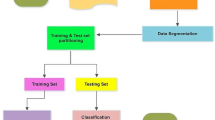Abstract
Continuous knee joint angle and surface electromyography (SEMG) signal prediction could improve exoskeleton performance. Prediction of SEMG and knee angle is helpful for the physiotherapist for the improvement in remote rehabilitation. Particle Swarm Optimization-Long Short Term Memory (PSO-LSTM) has been used to classify three movements (Flexion, Extension, Ramp Walking) and predict to improve exoskeleton performance. Five healthy subjects participated in testing the effectiveness of the model. Four knee muscles SEMG signals, namely biceps femoris, vastus medialis, rectus femoris and semitendinosus, and knee angle, were used as model inputs. RMSE, r, and R2 were taken as evaluation parameters to identify the model's robustness for predicting SEMS signal and knee angle. The proposed model was used to classify three movements (Flexion, Extension, Ramp Walking) with an accuracy of 98.58%. The LSTM-PSO results were compared with random LSTM for predicting and classifying the three movements, and the performance of the proposed model was found to be better. This model could be beneficial in rehabilitating stroke patients in remote areas and designing assistive devices.













Similar content being viewed by others
Data Availability
The data used in this article will be shared on a reasonable request to the corresponding author.
References
C. Xie and D. Wang, A long short-term memory neural network model for knee joint acceleration estimation using mechanomyography signals, International Journal of Advanced Robotic Systems, vol. 17, no. 6. 2020.
R. Kianifar and L. Alexander, Automated assessment of dynamic knee valgus and risk of knee injury during the single leg squat. IEEE J. Transl. Eng. Heal. Med., 5 (2017) 13.
Z.G. Peter, Time series forecasting using a hybrid ARIMA and neural network model. Neurocomputing, 50 (2003) 159–175.
J. Chen and X. Zhang, Surface EMG based continuous estimation of human lower limb joint angles by using deep belief networks. Biomedical Signal Processing and Control, 40 (2018) 335–342.
Q. Liu and M. Liangyun, Knee joint angle prediction based on muscle synergy theory and generalized regression neural network, in IEEE/ASME International Conference on Advanced Intelligent Mechatronics (AIM), 2018, p. 5.
Y. Huang and Z. He, Real-time intended knee joint motion prediction by deep-recurrent neural networks. IEEE Sens. J., 19 (2019) 11503–11509.
C. Ma and L. Chuang, Continuous estimation of upper limb joint angle from sEMG signals based on SCA-LSTM deep learning approach. Biomed. Signal Process. Control, 61 (2020) 13.
J. Chen, X. Zhang, Y. Cheng and N. Xi, Surface EMG based continuous estimation of human lower limb joint angles by using deep belief networks. Biomed. Signal Process. Control, 40 (2018) 335–342.
W. Chao and G. Weiyu, sEMG-based continuous estimation of grasp movements by long-short term memory network. Biomed. Signal Process. Control, 59 (2020) 14.
W. Ying and W. Qun, Deep back propagation-long short-term memory network based upper-limb sEMG signal classification for automated rehabilitation. Biocybern. Biomed. Eng., 40 (2020) 987–1001.
P. Xia and H. Jie, EMG-based estimation of limb movement using deep learning with recurrent convolutional neural networks. Artif. Organs, 42 (2017) 11.
B. Tianzhe and X. Shengquan, A CNN-LSTM hybrid model for wrist kinematics estimation using surface electromyography. IEEE Trans. Instrum. Meas., 70 (2021) 9.
C. Millar and N. Siddique, LSTM classification of sEMG signals for individual finger movements using low cost wearable sensor, in 2020 International Symposium on Community-centric Systems (CcS), 2020, p. 8.
Y. ZHANG and S. YANG, Prediction on the highest price of the stock based on PSO-LSTM neural network, in 3rd International Conference on Electronic Information Technology and Computer Engineering (EITCE), 2019, p. 4.
V. Gundu and S. P. Simon, PSO–LSTM for short term forecast of heterogeneous time series electricity price signals, J. Ambient Intell. Humaniz. Comput., p. 11, 2020.
S. Hochreiter and J. Urgen Schmidhuber, “Long Short-Term Memory,” Neural Comput., vol. 9, no. 8, 1997.
X. Yuan and C. Chen, Prediction interval of wind power using parameter optimized Beta distribution based LSTM model. Appl. Soft Comput. J., 82 (2019) 10.
B. Shao and M. Li, Nickel price forecast based on the LSTM neural network optimized by the improved PSO algorithm. Math. Probl. Eng., 2019 (2019) 15.
A. S. Santra and J. L. Lin, Integrating long short-term memory and genetic algorithm for short-term load forecasting, Energies, vol. 12, no. 11, 2019.
H. Chung and K. S. Shin, Genetic algorithm-optimized long short-term memory network for stock market prediction, Sustainability, vol. 10, no. 10, 2018.
T. Damrongsakmethee and V. Neagoe, Stock market prediction using a deep learning approach, in 12th International Conference on Electronics, Computers and Artificial Intelligence (ECAI), 2020, p. 6.
H. Yusheng and Y. Gao, A new financial data forecasting model using genetic algorithm and long short-term memory network. Neurocomputing, 425 (2021) 207–218.
SENIAM, Recommendations for Sensor Locations on Individual Muscles, Available at http://seniam.org/sensor_location.htm. 2013.
A. Sohane and R. Agarwal, Knee muscle force estimating model using machine learning approach. Comput. J., 00 (2020) 11.
K. Neelesh and V. S, System for measurement of joint range of motion using inertial sensors, Biomed. Res., vol. 28, pp. 3699–3703, 2017.
X. Ma and Y. Liu, Continuous estimation of knee joint angle based on surface electromyography using a long short-term memory neural network and time-advanced feature, Sensors, vol. 20, no. 17, 2020.
V. Gundu and S. P. Simon, PSO–LSTM for short term forecast of heterogeneous time series electricity price signals, J. Ambient Intell. Humaniz. Comput., 2020.
Acknowledgements
Thanks to the Department of Science and Technology, New Delhi, for their financial support (Grant No# SEED/TIED/031/2013).
Author information
Authors and Affiliations
Corresponding author
Additional information
Publisher's Note
Springer Nature remains neutral with regard to jurisdictional claims in published maps and institutional affiliations.
Supplementary Information
Rights and permissions
About this article
Cite this article
Sohane, A., Agarwal, R. A Single Platform for Classification and Prediction using a Hybrid Bioinspired and Deep Neural Network (PSO-LSTM). MAPAN 37, 47–58 (2022). https://doi.org/10.1007/s12647-021-00478-6
Received:
Accepted:
Published:
Issue Date:
DOI: https://doi.org/10.1007/s12647-021-00478-6




